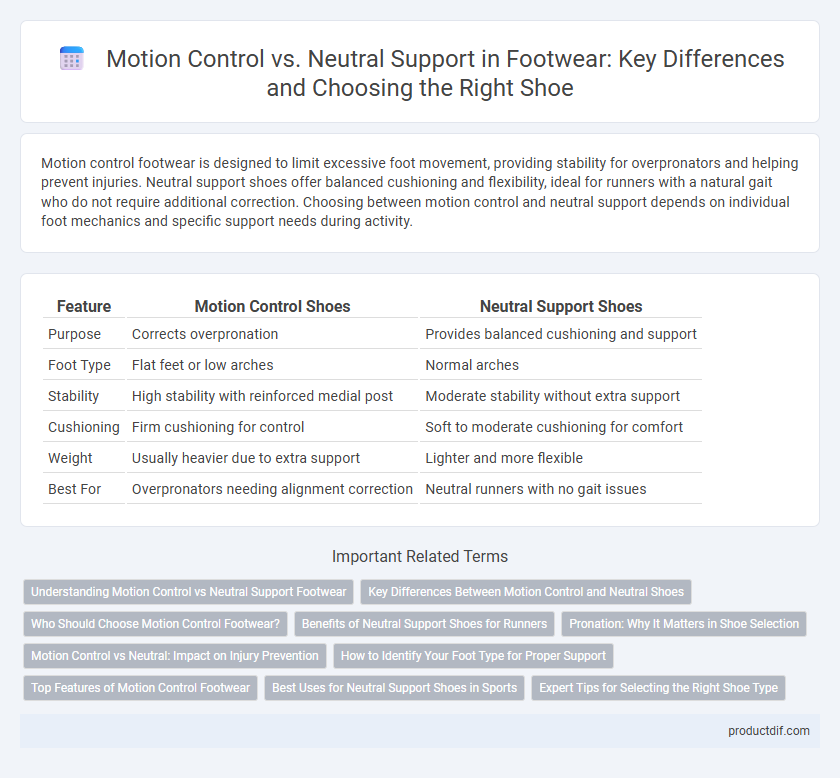Motion control footwear is designed to limit excessive foot movement, providing stability for overpronators and helping prevent injuries. Neutral support shoes offer balanced cushioning and flexibility, ideal for runners with a natural gait who do not require additional correction. Choosing between motion control and neutral support depends on individual foot mechanics and specific support needs during activity.
Table of Comparison
| Feature | Motion Control Shoes | Neutral Support Shoes |
|---|---|---|
| Purpose | Corrects overpronation | Provides balanced cushioning and support |
| Foot Type | Flat feet or low arches | Normal arches |
| Stability | High stability with reinforced medial post | Moderate stability without extra support |
| Cushioning | Firm cushioning for control | Soft to moderate cushioning for comfort |
| Weight | Usually heavier due to extra support | Lighter and more flexible |
| Best For | Overpronators needing alignment correction | Neutral runners with no gait issues |
Understanding Motion Control vs Neutral Support Footwear
Motion control footwear is engineered to limit excessive pronation by providing firm arch support and stiffer midsoles, ideal for overpronators requiring enhanced stability during movement. Neutral support footwear offers balanced cushioning and flexibility without restricting natural foot motion, best suited for runners with a neutral gait or mild supination. Selecting the appropriate footwear based on gait analysis improves comfort, reduces injury risk, and optimizes athletic performance.
Key Differences Between Motion Control and Neutral Shoes
Motion control shoes provide enhanced stability by featuring stiffer midsoles and reinforced heel counters, designed to limit excessive foot motion and prevent overpronation in runners. Neutral shoes offer flexible cushioning without extra support, catering to individuals with normal arches and efficient biomechanics who require shock absorption rather than motion restriction. The key differences lie in their structural support, targeting overpronators with motion control shoes and neutral runners with lightweight, more flexible footwear.
Who Should Choose Motion Control Footwear?
Motion control footwear is ideal for runners or individuals with flat feet, overpronation, or low arches who require extra stability and support to prevent excessive inward foot roll. These shoes often feature reinforced midsoles, medial posts, and firm heel counters to correct gait biomechanical issues and reduce injury risk. People experiencing frequent ankle or knee pain due to overpronation also benefit significantly from motion control shoe designs.
Benefits of Neutral Support Shoes for Runners
Neutral support shoes offer enhanced cushioning and flexibility designed to accommodate natural foot motion, reducing the risk of overcorrection injuries commonly linked to motion control shoes. These shoes provide optimal shock absorption and encourage efficient stride mechanics, benefiting runners with normal pronation. The lightweight design and breathable materials also contribute to improved comfort and performance during long-distance runs.
Pronation: Why It Matters in Shoe Selection
Understanding pronation is crucial for selecting footwear that offers effective motion control or neutral support to prevent injury and enhance performance. Motion control shoes are designed to limit excessive inward rolling of the foot (overpronation) by providing firm arch support and a stiffer heel counter, while neutral support shoes accommodate natural pronation with cushioning and flexibility. Choosing the right shoe type based on individual pronation patterns reduces strain on the ankles and knees, promoting better stability and comfort during walking or running.
Motion Control vs Neutral: Impact on Injury Prevention
Motion control shoes are designed to limit excessive foot motion, reducing the risk of overuse injuries such as plantar fasciitis and shin splints in runners with flat arches or overpronation. Neutral support shoes accommodate natural foot motion, promoting flexibility and comfort for those with normal arches and neutral gait patterns. Selecting the appropriate footwear based on individual biomechanics significantly decreases injury incidence by stabilizing foot alignment during impact and reducing stress on muscles and joints.
How to Identify Your Foot Type for Proper Support
Identifying your foot type for proper support involves analyzing your arch height and pronation pattern through a wet test or gait analysis. Motion control shoes suit overpronators with low arches by providing enhanced stability and support to prevent inward rolling. Neutral support shoes cater to those with normal arches and neutral pronation, offering balanced cushioning without extra correction.
Top Features of Motion Control Footwear
Motion control footwear offers superior stability through reinforced arch support and rigid midsoles designed to limit overpronation, making them ideal for runners with flat feet or low arches. Key features include enhanced medial posts, firm heel counters, and structured cushioning that provide excellent control during gait cycles. These shoes prioritize durability and support to reduce injury risk in individuals needing maximum motion correction.
Best Uses for Neutral Support Shoes in Sports
Neutral support shoes are ideal for athletes with a natural gait who exhibit minimal overpronation, providing balanced cushioning and flexibility to enhance performance. These shoes excel in activities requiring speed and agility, such as running, tennis, and basketball, where efficient energy return and natural foot movement are crucial. Incorporating neutral support footwear in sports minimizes injury risk while optimizing comfort and responsiveness during dynamic motions.
Expert Tips for Selecting the Right Shoe Type
Choosing between motion control and neutral support shoes depends on your foot type and gait mechanics; motion control shoes are ideal for overpronators seeking maximum stability, while neutral support shoes suit runners with a natural stride. Expert tips recommend conducting a professional gait analysis and considering factors such as arch height, pronation degree, and injury history to ensure optimal fit and performance. Proper footwear selection enhances comfort, reduces injury risk, and improves overall running efficiency.
Motion control vs Neutral support Infographic

 productdif.com
productdif.com